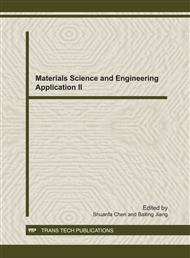p.133
p.138
p.144
p.148
p.154
p.160
p.166
p.170
p.174
Application of Bailey Method for Aggregate Grading Design of Continuous Dense Gradation Asphalt Mixture
Abstract:
On the base of discussion and analysis of Bailey method for Aggregate Grading Design, the paper expounds particularly how to design Aggregate gradation of continuous dense gradation asphalt mixture by a accurate computational procedure, with the example of AC-20(asphalt cement 20 version) continuous dense gradation asphalt mixture design. It will benefit for designer to design graduation well. This also suggests using three ratios, [CA] Ratio, [FAc] Ratio and [FAf] Ratio, to analyze composite gradation. Thus the designed mixture has good rutting resistance and endurance. The key technologies about this design method were studied. In the context of the same asphalt binder and aggregate, two kinds of AC-20 aggregate gradations have been designed by using Bailey method and the routine method. With these two methods, several kinds of specimens for pavements performance tests has been made at separate optimum asphalt contents. These experiments have shown that the asphalt mixture designed by Bailey method has a better rutting resistance at high temperature, crack resistance at low temperature and durability than the one designed by the routine method. In these experiments, the dynamic stability is enhanced by one time to 6749 times/mm in rutting Test; the Tensile Strength Ratio (TSR) is improved greatly in Water Susceptibility Tensile Strength Ratio Test, which is much larger than the required value in the specification; the maximum bending and tension strain is also enhanced. As a result, Bailey method can be widely used in aggregate grading design in practical engineering.
Info:
Periodical:
Pages:
154-159
Citation:
Online since:
December 2011
Authors:
Price:
Сopyright:
© 2012 Trans Tech Publications Ltd. All Rights Reserved
Share:
Citation:


